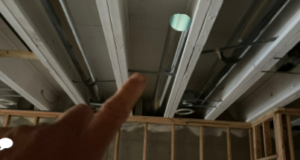As we start to get older, one of the conversations that occurs at some point is… how long do we want to stay in our home? For some, the option of moving to a senior living community (or even just downsizing) is not appealing or feasible, for a number of reasons including financial means, the stress of moving, emotional attachment to a family home, or the fear of aging even more quickly once they lose their independence. “More than three-quarters of U.S. adults age 50 and older want to stay in their current homes as long as possible”. No matter what your age is though, it’s important to consider modifications to your home to make it safe for you and your guests. Did you know that over one in four Americans age 65+ fall each year? Whether you have a health challenge and need more support throughout your home, or would like to proactively ensure your home is safe for your family and guests, making a few small changes doesn’t have to break the bank and can give you peace of mind in your home.
Ensuring Safety at Home
Here are some key safety measures that can be taken to create a secure living environment as you age gracefully in your home. It’s important to be proactive vs. reactive especially when it comes to health and safety.
1. Install Handrails and Grab Bars: Adding handrails along staircases, in bathrooms, and next to the bed can provide much-needed support and stability for seniors.
2. Improve Interior Lighting: Adequate lighting can help prevent falls. Make sure that all areas of the home, especially hallways, staircases, and entranceways, are well-lit.
3. Remove Tripping Hazards: Remove or secure loose rugs, electrical cords, and clutter that can pose tripping hazards. Choose non-slip mats for bathrooms and ensure that all carpets are securely fastened.
4. Bathroom Modifications: Consider installing a walk-in shower with a seat, a raised toilet seat, and a handheld showerhead to make bathing safer and more comfortable.
5. Enhance Accessibility: If possible, consider widening doorways to accommodate wheelchairs or walkers. Lowering countertop heights in the kitchen can also increase accessibility.
6. Emergency Response System: Invest in a reliable emergency response system that easily allows you to call for help when needed (especially important if you live alone!).
7. Regular Maintenance Checks: Stay on top of home maintenance to ensure that all systems and structures are in good condition.
8. Non-Slip Flooring: Choose flooring materials that offer good traction, such as non-slip tiles, to minimize the risk of slipping and falling.
9. Accessibility Features: Consider adding features like a ramp at the entrance, lever-style door handles, and easy-to-use faucets to make daily activities more manageable.
10. Exterior Lighting: Use bright lights or motion detection lights around steps, walkways and driveways to prevent falls in the dark.
By implementing these safety measures, we can create a home environment that promotes safety, independence and minimizes the risk of accidents in our homes. Selecting someone to check out your home in you area is going to help maximize their understanding of what you need. Musselman Home Improvement helps local families feel safe in their home. No matter if you are in Bucks County, Montgomery County, Lehigh County or Chester County…we are here to support your needs. Now is the time to make a safety checklist for your home and hire a professional if you need help.


